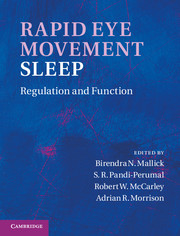Book contents
- Frontmatter
- Contents
- Contributors
- Preface
- Acknowledgments
- Organization
- Section I Historical context
- Section II General biology
- Section III Neuronal regulation
- Section IV Neuroanatomy and neurochemistry
- Section V Functional significance
- Section VI Disturbance in the REM sleep-generating mechanism
- 40 Narcolepsy and REM sleep
- 41 REM sleep and dreams: relationship to anxiety, psychosomatic, and behavioral disorders
- 42 REM sleep and emotion regulation
- 43 Neural modeling for cooperative/competitive regulation of REM sleep with NREM sleep and wakefulness
- 44 The selective mood-regulatory theory of dreaming: an adaptive, assimilative, and experimentally based theory of dreaming
- Index
- Plate section
- References
42 - REM sleep and emotion regulation
from Section VI - Disturbance in the REM sleep-generating mechanism
Published online by Cambridge University Press: 07 September 2011
- Frontmatter
- Contents
- Contributors
- Preface
- Acknowledgments
- Organization
- Section I Historical context
- Section II General biology
- Section III Neuronal regulation
- Section IV Neuroanatomy and neurochemistry
- Section V Functional significance
- Section VI Disturbance in the REM sleep-generating mechanism
- 40 Narcolepsy and REM sleep
- 41 REM sleep and dreams: relationship to anxiety, psychosomatic, and behavioral disorders
- 42 REM sleep and emotion regulation
- 43 Neural modeling for cooperative/competitive regulation of REM sleep with NREM sleep and wakefulness
- 44 The selective mood-regulatory theory of dreaming: an adaptive, assimilative, and experimentally based theory of dreaming
- Index
- Plate section
- References
Summary
Summary
Despite substantial research focusing on the interaction between sleep and cognition, especially memory, the impact of sleep and sleep loss on affective and emotional regulation has comparatively attracted much less attention. This might be surprising considering that nearly all psychiatric and neurological disorders with impaired mood express co-occurring abnormalities of sleep, and that many sleep disorders are accompanied by mood disturbances, thus suggesting an intimate relationship between sleep and emotion. Yet, recent studies evaluating subjective as well as objective measures of mood and affect, combined with insights from clinical observations and neuroimaging research, offer new evidence for the emerging role of sleep in regulating emotional brain function. In this chapter, we review clinical and neuroimaging data that support the existence of such complex interactions between sleep and emotion regulation. We report that (1) sleep disorders are frequently associated with affective symptoms; (2) patients with mood disorders often present with sleep disturbances; (3) sleep deprivation may transitorily alleviate depressive symptoms; (4) dream experiences may be highly emotional; (5) brain regions involved in emotion processing and regulation, such as the limbic (e.g., amygdala, anterior cingulate cortex) and ventromedial prefrontal regions, are strongly activated during REM sleep; (6) subjective mood assessments exhibit a circadian modulation. New data also show that some hypothalamic neuropeptides (hypocretin/orexin) play a dual role in the stabilization of sleep–wake states and on mesolimbic dopamine activity, with significant effects on neural plasticity related to emotional learning, reward processing, and addiction. Together, these seemingly disparate observations converge to indicate a physiological interplay between sleep–wake and emotional brain functions serving the modulation, the preparation, and the optimization of waking behavior.
- Type
- Chapter
- Information
- Rapid Eye Movement SleepRegulation and Function, pp. 427 - 436Publisher: Cambridge University PressPrint publication year: 2011
References
- 2
- Cited by



